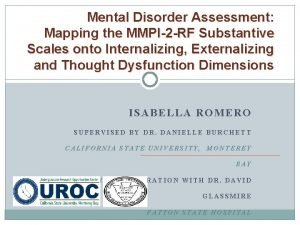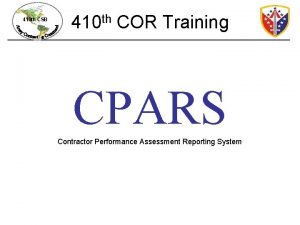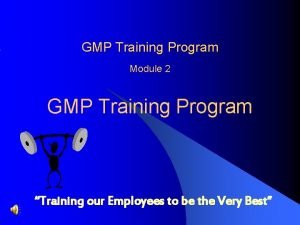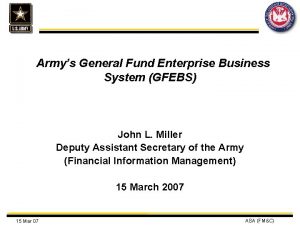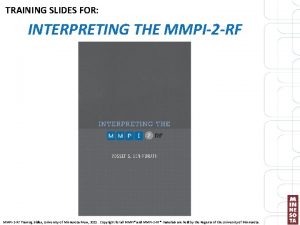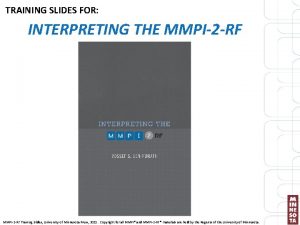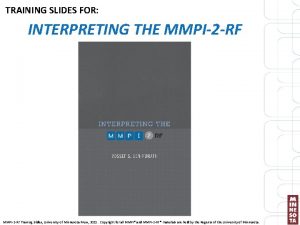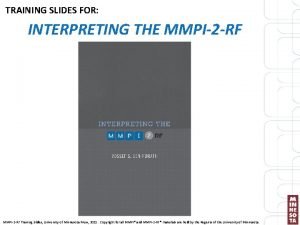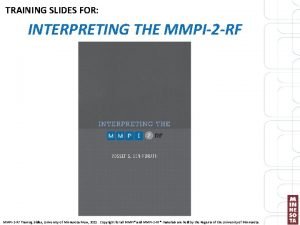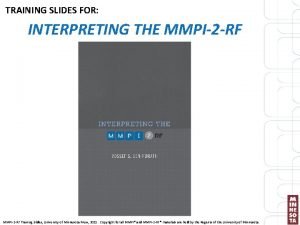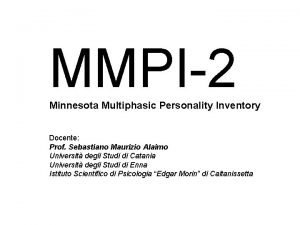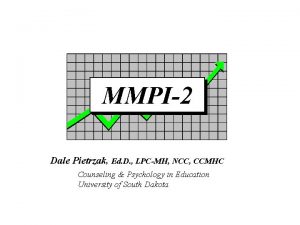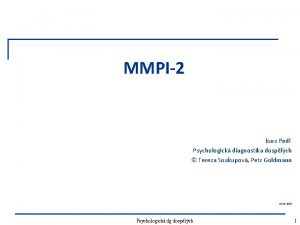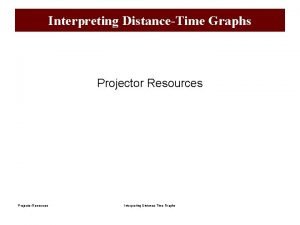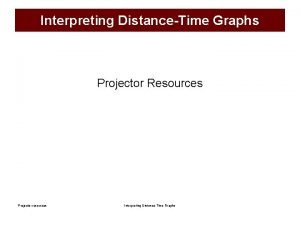TRAINING SLIDES FOR INTERPRETING THE MMPI2 RF Training

















- Slides: 17

TRAINING SLIDES FOR: INTERPRETING THE MMPI-2 -RF Training Slides, University of Minnesota Press, 2015. Copyright for all MMPI® and MMPI-2 -RF® materials are held by the Regents of the University of Minnesota.

CHAPTER 10: MMPI-2 -RF APPRAISALS MMPI-2 -RF Training Slides, University of Minnesota Press, 2015. Copyright for all MMPI® and MMPI-2 -RF® materials are held by the Regents of the University of Minnesota.

MMPI-2 -RF Appraisals • Generally favorable • Test adopted for routine use in mental health, medical, forensic, and personnel screening evaluations • Key advantages: – Length – Modernity – String Empirical Foundations MMPI-2 -RF Training Slides, University of Minnesota Press, 2015. Copyright for all MMPI® and MMPI-2 -RF® materials are held by the Regents of the University of Minnesota.

MMPI-2 -RF Appraisals • Graham (2012) and Greene (2011) provide extensive coverage of the MMPI-2 -RF • Provide detailed recommendations for use as well as appraisals of the inventory, including some advantages and disadvantages. • Advantages include brevity, ease of interpretation, and links to the contemporary literature on personality and psychopathology. MMPI-2 -RF Training Slides, University of Minnesota Press, 2015. Copyright for all MMPI® and MMPI-2 -RF® materials are held by the Regents of the University of Minnesota.

MMPI-2 -RF Appraisals • Both authors mention the loss of information from Clinical Scale code types as a potential disadvantage of the MMPI-2 -RF. • However, Graham (2012) notes that – “one could argue that code types evolved largely as a way to deal with the heterogeneity of the Clinical Scales and are not necessary because of the homogeneity of the RC Scales and other MMPI-2 -RF scales” (p. 414). MMPI-2 -RF Training Slides, University of Minnesota Press, 2015. Copyright for all MMPI® and MMPI-2 -RF® materials are held by the Regents of the University of Minnesota.

MMPI-2 -RF Appraisals • Both authors also discuss the absence of specific supplementary MMPI-2 measures as disadvantages. • Graham (2012) lists the Mac-R, Ho and Es scales • As noted earlier, the MMPI-2 -RF Technical Manual reports correlations between MMPI-2 and MMPI-2 -RF scales. • Examination of these statistics indicates that MAC-R is most closely associated with the Higher-Order BXD Scale of the MMPI-2 -RF • RC 3 assesses the cynical hostility component of the Ho scale. • Es is a more heterogeneous measure that does not have a direct parallel in the MMPI-2 -RF Training Slides, University of Minnesota Press, 2015. Copyright for all MMPI® and MMPI-2 -RF® materials are held by the Regents of the University of Minnesota.

MMPI-2 -RF Appraisals • Greene (2011): – “The “MMPI-2” in MMPI-2 -RF is a misnomer because the only relationship to the MMPI-2 is its use of a subset of the MMPI-2 item pool, its normative group, and similar validity scales. The MMPI-2 -RF should not be conceptualized as a revised or restructured form of the MMPI-2, but as a new self-report inventory that chose (sic) to select its items from the MMPI-2 item pool and use its normative group. ” (p. 22) • However, naming this instrument, made up exclusively of MMPI-2 items and standardized on the MMPI-2 norms, anything but a restructured version of the MMPI-2 would in fact be misleading. MMPI-2 -RF Training Slides, University of Minnesota Press, 2015. Copyright for all MMPI® and MMPI-2 -RF® materials are held by the Regents of the University of Minnesota.

MMPI-2 -RF Appraisals • Greene (2011): – “clinicians who use the MMPI-2 -RF should realize that they have forsaken the MMPI-2 and its 70 years of clinical and research history, and they are learning a new inventory” (p. 22). • Nonetheless, he provides detailed recommendations on how to use the MMPI-2 -RF, which span roughly onefourth of his book and include several case studies. • Greene has also developed a commercially available computer-based interpretive report for the MMPI-2 -RF. • It can, therefore, reasonably be inferred that Greene does not view his expressed concerns as cause for not using the test. MMPI-2 -RF Training Slides, University of Minnesota Press, 2015. Copyright for all MMPI® and MMPI-2 -RF® materials are held by the Regents of the University of Minnesota.

MMPI-2 -RF Appraisals • Butcher (2011) provides an exclusively negative appraisal of the MMPI-2 -RF and recommends against its use. • Much of Butcher’s appraisal consists of repetition of criticisms of the RC Scales without consideration of the substance of published responses to these criticisms (Tellegen et al. , 2006, 2009). • Butcher’s claim that the RC Scales “underpathologize” is contradicted by data (Sellbom, et al. , 2006, Tellegen et al. , 2006) MMPI-2 -RF Training Slides, University of Minnesota Press, 2015. Copyright for all MMPI® and MMPI-2 -RF® materials are held by the Regents of the University of Minnesota.

MMPI-2 -RF Appraisals • Butcher (2011) also lists some new concerns, including: – The relatively low reliability estimates for some Specific Problems Scales • However, as discussed earlier, the reliability estimates reported in the Technical Manual need to be considered in the context of the associated measurement error statistics, which are also reported – “the majority of the scales incorporated in the MMPI-2 -RF are insufficiently validated to provide the practitioner with confidence in assessment” (p. 189) • This is belied by the unparalleled quantity and quality of external correlate data reported in the Technical Manual (discussed earlier). MMPI-2 -RF Training Slides, University of Minnesota Press, 2015. Copyright for all MMPI® and MMPI-2 -RF® materials are held by the Regents of the University of Minnesota.

MMPI-2 -RF Appraisals • Butcher (2011) expresses concern about the loss of items related to work adjustment and treatment readiness that resulted from pruning the item pool from 567 to 338 statements. – The items alluded to here are scored on two of the MMPI-2 Content Scales, Work Interference (WRK) and Negative Treatment Indicators (TRT). – Data reported in the Technical Manual indicate that both these scales are oversaturated with demoralization variance and their distinctive features are assessed on the MMPI-2 -RF with the Inefficacy (NFC) and Helplessness/Hopelessness (HLP) Scales, respectively. – Treatment considerations are included in the interpretive recommendations for most of the MMPI-2 -RF substantive scales. MMPI-2 -RF Training Slides, University of Minnesota Press, 2015. Copyright for all MMPI® and MMPI-2 -RF® materials are held by the Regents of the University of Minnesota.

MMPI-2 -RF Appraisals • Butcher (2011) remarks that “it is likely that the interpretations and conclusions drawn from the MMPI-2 -RF will differ substantially from an MMPI-2 interpretation” (p. 190) and expresses concern that this may create confusion. – However, because the two MMPI versions are scored from the test-taker’s responses to the same set of items, it is unlikely that two conflicting clinical pictures will emerge. – The more likely outcome is that the picture portrayed by the MMPI-2 -RF may be more readily and clearly discerned. – Confusion can be avoided by being clear about which version of the MMPI was used in a given assessment. MMPI-2 -RF Training Slides, University of Minnesota Press, 2015. Copyright for all MMPI® and MMPI-2 -RF® materials are held by the Regents of the University of Minnesota.

MMPI-2 -RF Appraisals • Elsewhere, Butcher (2010) is critical of use of non-gendered norms with the MMPI-2 -RF, stating: Unlike the original MMPI and MMPI-2, in which separate gender norms were provided, the MMPI-2 RF authors combined genders into one comparison sample. This situation may result in different standards being applied for men and women in assessment and prediction. Further study of this potential bias needs to be conducted. However, the MMPI-2 -RF manuals do not provide the information necessary for exploring this question because raw score data by gender are not reported. (p. 14) MMPI-2 -RF Training Slides, University of Minnesota Press, 2015. Copyright for all MMPI® and MMPI-2 -RF® materials are held by the Regents of the University of Minnesota.

MMPI-2 -RF Appraisals • This criticism reflects a fundamental misunderstanding of group-specific norms. • Contrary to Butcher’s assertion, gender-based norms create different standards for men and women, which can mask meaningful gender differences (cf. , Reynolds & Kamphaus, 2002, 2004; Reynolds & Livingston, 2012). • Non-gendered norms apply the same standard to men and women’s test scores and reflect rather than mask actual gender differences. MMPI-2 -RF Training Slides, University of Minnesota Press, 2015. Copyright for all MMPI® and MMPI-2 -RF® materials are held by the Regents of the University of Minnesota.

MMPI-2 -RF Appraisals • Butcher’s (2010) assertion that the MMPI-2 -RF manuals do not provide information necessary to explore this question is also incorrect. • As noted earlier, means and standard deviations of scores on the 51 MMPI-2 -RF scales are reported in the Technical Manual by gender for a wide range of samples, including the normative sample. • Gender-based norms would have gender differences reflected in these data by setting the mean T score for each gender at 50. • Moreover, inclusion of extensive, gender-specific descriptive data in the Technical Manual allows MMPI-2 -RF users to compare a test -taker’s results with samples of men and women tested in a wide range of mental health, medical, forensic, personnel screening, and non-clinical settings. MMPI-2 -RF Training Slides, University of Minnesota Press, 2015. Copyright for all MMPI® and MMPI-2 -RF® materials are held by the Regents of the University of Minnesota.

MMPI-2 -RF Appraisals • Nichols (2011) mainly repeats Butcher’s (2010, 2011) criticisms, focusing mostly on his own previous (Nichols, 2006) critique of the RC scales. • Detailed responses to Nichols’s earlier RC Scale critiques are provided by Tellegen and colleagues (2006, 2009). MMPI-2 -RF Training Slides, University of Minnesota Press, 2015. Copyright for all MMPI® and MMPI-2 -RF® materials are held by the Regents of the University of Minnesota.

For additional information on this chapter, please reference: Ben-Porath, Y. S. (2012). Interpreting the MMPI-2 -RF. Minneapolis: University of Minnesota Press. MMPI-2 -RF Training Slides, University of Minnesota Press, 2015. Copyright for all MMPI® and MMPI-2 -RF® materials are held by the Regents of the University of Minnesota.
 Multidimensional calm test
Multidimensional calm test Define psychic determinism
Define psychic determinism Mmpi2
Mmpi2 A small child slides down the four frictionless slides
A small child slides down the four frictionless slides A spring loaded gun shoots a plastic ball
A spring loaded gun shoots a plastic ball Ppc training slides
Ppc training slides Absence management training
Absence management training Wide area workflow
Wide area workflow Cpars training slides
Cpars training slides Master resilience training modules
Master resilience training modules Insider threat awareness training
Insider threat awareness training Gmp training material
Gmp training material Gfebs training slides
Gfebs training slides Anti bribery and corruption training slides
Anti bribery and corruption training slides Dpas training slides
Dpas training slides Cpars ratings examples
Cpars ratings examples Insider threat awareness army
Insider threat awareness army Government purchase card training slides
Government purchase card training slides


